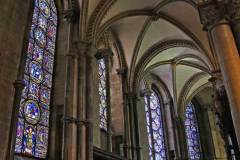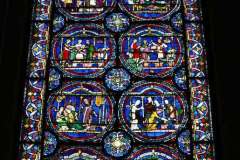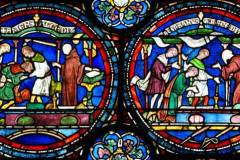There were originally 12 Miracle windows, six on the north side and six on the south side of the shrine of St Thomas in the centre of the Trinity chapel (Image 1). All the windows were complete by the time the Translation of St Thomas’ remains from the crypt to the Trinity chapel on 7th July 1220. As in the south windows, there are scenes portraying miracles that were seen to have occurred as a result of prayer to, or the intervention of, St Thomas.
The most westerly one is rather different from the other Miracle windows and is therefore described under ‘Life of Becket’. The next window is a 19th century replacement and the third is original with late 12th century glass and some Victorian replacement panels but has been truncated in the 15th century to allow the construction of the chantry chapel below; the remaining three windows contain original early 13th century glass, with some replacement panels created in the 19th century by the glazier George Austin Jr.(Image 2).
There are many scenes portrayed in these four original windows. The stories they depict were drawn from Benedict of Peterborough’s Passion and Miracles of St Thomas Becket. It is therefore possible to identify the names and ailments of the people portrayed in the windows. Latin inscriptions explain the stories.
What to see:
Selecting just one story in window number 4 (Image 3), from the left, second row up, left roundel:
- In this first scene, Henry, an insane young man from the village of Fordwich, a nearby village, is being dragged and beaten by his two guardians to St Thomas’ tomb with his hands tied behind his back and being beaten with sticks. There is clearly a lot of action as Henry’s cloak has fallen in front of him, one guardian has his cloak caught up on a candlestick on the tomb and the monk who is looking on is apprehensive. The inscription, AMENS ACCEDIT, translates as “The insane man approaches.”
- In the right hand roundel, Henry who has spent a night at the tomb, has become calm and kneels in prayer. The guardians are expressing amazement, and the monk slaps his forehead in astonishment. The rope that bound Henry and the sticks are left as a ‘ex voto’, a thanks offering. The inscription, ORAT, SANUSQUE RECEDIT, translates as “He prays, and healed, he leaves.”
- This story is told in Benedict of Peterborough’s miracle collection.
AT
June 2025. CHAS is very grateful to Rachel Koopmans has reviewed and edited this webpage.



